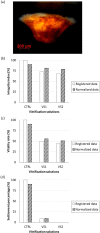First instance of settlement by cryopreserved coral larvae in symbiotic association with dinoflagellates
- PMID: 31827193
- PMCID: PMC6906398
- DOI: 10.1038/s41598-019-55374-6
First instance of settlement by cryopreserved coral larvae in symbiotic association with dinoflagellates
Abstract
Coral reefs are suffering on a global scale due to human impacts, thereby necessitating cryopreservation efforts. The objective of this study was to develop a suitable vitrification and laser warming protocol for larvae of the scleractinian coral Seriatopora caliendrum, which inherit their dinoflagellate algal symbionts vertically. Toxicity experiments were conducted with the cryoprotectants (CPAs) ethylene glycol (EG), propylene glycol (PG), dimethyl sulfoxide (DMSO), glycerol (GLY), and methanol (METH; listed in order from least to most toxic), and larvae were subjected to vitrification and laser warming using 2 M EG + 1 M PG and 2 M EG + 1 M DMSO. Vitrification and laser warming (300 V, 10 ms pulse width, 2 mm beam diameter) using a vitrification solution of 2 M EG + 1 M PG, 40% w/v Ficoll, and 10% v/v gold nanobars (GNB) at a final concentration of 1.2 × 1018 GNB/mL and a characteristic wavelength of 535 nm resulted in larvae with vitality and settlement percentages of 55 and 9%, respectively. This represents the first successful instance of cryopreservation of coral larvae that proceeded to settle upon warming, and suggests that the vitrification and ultra-fast laser warming approach may be applicable to other threatened marine species.
Conflict of interest statement
The authors declare no competing interests.
Figures





References
-
- de Groot R, et al. Global estimates of the value of ecosystems and their services in monetary units. Ecosyst Ser. 2012;1(1):50–611. doi: 10.1016/j.ecoser.2012.07.005. - DOI
-
- Pet-soede C, Cesar H, Pet J. An economic analysis of blast fishing on Indonesian coral reefs. Environ Conserv. 1999;26(2):83–93. doi: 10.1017/S0376892999000132. - DOI
-
- Wilkinson, C. Status of Coral Reefs of the World, Australian Institute of Marine Science, Townsville. (2002).
MeSH terms
Substances
LinkOut - more resources
Full Text Sources

